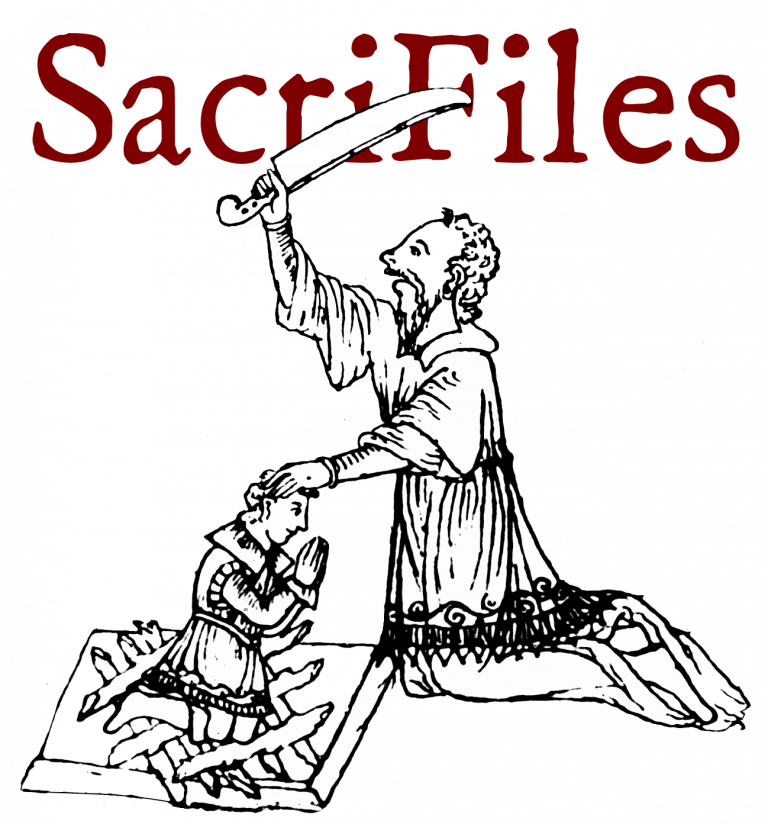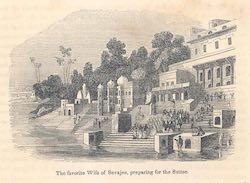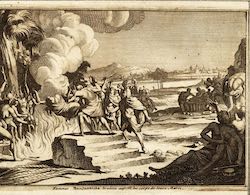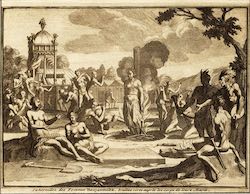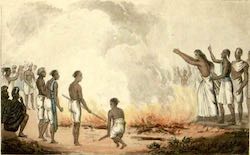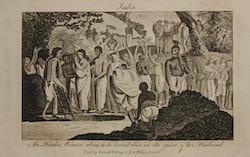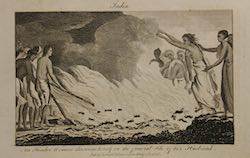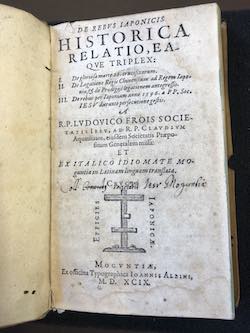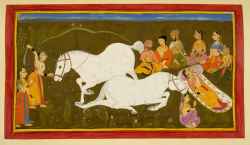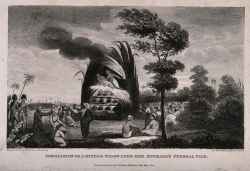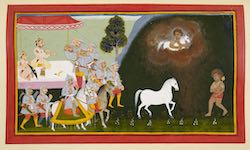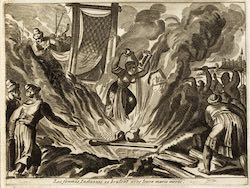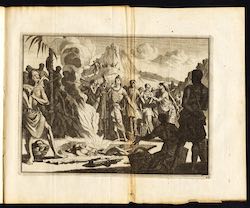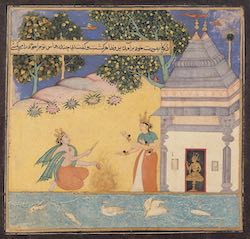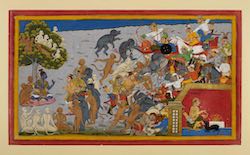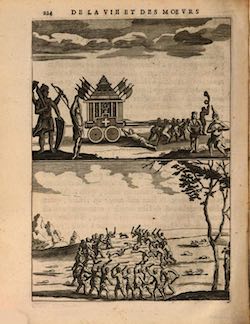Keyword: India
Favorite Wife of Sevajee (1851)
http://www.columbia.edu/itc/mealac/pritchett/00routesdata/1800_1899/hinduism/sati/sati.html
Femmes Benjanoises brulees (1725)
from: van der Aa, P. La galerie agreable du monde. Tome premier des Indes Orientales, Leiden, c. 1725
http://www.columbia.edu/itc/mealac/pritchett/00routesdata/1800_1899/hinduism/sati/sati.html
Funerailles des Femmes Benjanoises (1725)
from: van der Aa, P. La galerie agreable du monde. Tome premier des Indes Orientales, Leiden, c. 1725
http://www.columbia.edu/itc/mealac/pritchett/00routesdata/1800_1899/hinduism/sati/sati.html
Hindoo Widow Burning Herself with the Corpse of the Husband (1820)
from: Shoberl, F. The World in Miniature: Hindoostan, London, Ackerman, 1820s
http://www.columbia.edu/itc/mealac/pritchett/00routesdata/1800_1899/hinduism/sati/sati.html
Hindoo Woman about to be Buried (1811)
from: Goldsmith, J. Geography on a Popular Plan, London, Richard Phillips, 1811
http://www.columbia.edu/itc/mealac/pritchett/00routesdata/1800_1899/hinduism/sati/sati.html
Hindoo Woman throwing herself (19th century?)
http://www.columbia.edu/itc/mealac/pritchett/00routesdata/1800_1899/hinduism/sati/sati.html
Historica Relatio1 (1598)
from: Peruschi, G. Historica Relatio, de Potentissimi Regis Mogor, Mainz, Breem, 1598
Historica Relatio2 (1598)
from: Peruschi, G. Historica Relatio, de Potentissimi Regis Mogor, Mainz, Breem, 1598
Horse sacrifice (Asvamedha) (1712)
from: Ramayana, Bala Kanda, Ms Add. 15295, fol. 33
British Library, London [from Udaipur]
Immolation of a Hindoo Widow (1814)
from: Lester. The Gallery of Nature and Art, 1814
London, Wellcome Collection
In the palace, Rāvaṇa and his remaining brothers and sons are bowed down by grief and Rāvaṇa wonders how he can ever be victorious in this conflict, when so many demon champions have been slain. Another son, Indrajit, boasts that he will overcome Rāma and Lakṣmaṇa and sets out in his chariot, surrounded by other demons on elephants, horses and in chariots. In a separate chamber (the text actually says on the battlefield), he prepares offerings, seizing a young black goat by the neck, to the god of Fire in order to conjure up his most magical weapons and to make himself invisible. (ca 1653)
from: Ramayana [ms Add. 15297(1), fol. 97]
British Library, London [from Udaipur]
Indian Woman Burning Alive (18th century)
http://www.columbia.edu/itc/mealac/pritchett/00routesdata/1800_1899/hinduism/sati/sati.html
King Sagara performs a sacrifice (1712)
from: Ramayana, Bala Kanda
British Library, Add. 15295, f.105
Les femmes Indiennes se brulent (1725)
from: van der Aa, P. La galerie agreable du monde. Tome premier des Indes Orientales, Leiden, c. 1725
http://www.columbia.edu/itc/mealac/pritchett/00routesdata/1800_1899/hinduism/sati/sati.html
Les veuves du Cormandel (1725)
from: van der Aa, P. La galerie agreable du monde. Tome premier des Indes Orientales, Leiden, c. 1725
http://www.columbia.edu/itc/mealac/pritchett/00routesdata/1800_1899/hinduism/sati/sati.html
Naauw-keurige aanteekeningen van William Methold (1707)
from: van der Aa, P. Naauw-keurige aanteekeningen van William Methold, Presiden van de Engelsse Maatschappy, gehouden op sijn Voyagie, in het jaar 1619, Leiden, 1619
http://www.columbia.edu/itc/mealac/pritchett/00routesdata/1800_1899/hinduism/sati/sati.html
Narasimha Avatar of Vishn (1760)
from: Illustrated folio from a Bhagavata Purana (Ancient Stories of the Lord). Nurpur Fort, Nurpur, Himachal Pradesh, India
Nasli and Alice Heeramaneck Collection, Museum Associates Purchase, LACMA (M.82.42.8)
Rāma sends out his entire army, headed by Lakṣmaṇa and Vibhīṣaṇa, to fight Indrajit at the Nikumbhilā grove, where he is performing more magical sacrifices. Indrajit is sacrificing to the fire again with a black goat, while around him a furious battle is raging between Lakṣmaṇa and his allies and the other demons. Vibhīṣaṇa has advised Rāma to send Lakṣmaṇa to finish off Indrajit at the place where he is performing his magical arts, before he can make himself even more powerful. Inscribed above Indrajit: Iṃdrajit. (ca 1653)
from: Ramayana [ms Add. 15297(1), fol. 115]
British Library, London [from Udaipur]
Ritual killing of a goat and a fox during ceremonies in honor of Vishnu and Shiva (1670)
from: Abraham Rogerius, Le Théâtre de l’idolatrie ou la porte ouverte, Amsterdam, Jean Schipper, 1670, p. 224
